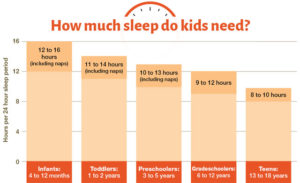Healthy Sleep Habits
A common concern that we hear from children and their parents is difficulty with sleep. How much sleep does a child need? Every child is different but in general the following chart is a good rule-of-thumb for sleep needs based on age.

![]()
If your child is not getting the recommended amount of sleep for their age, it can be hard to make the changes necessary in your daily routine to achieve more sleep. For extra motivation, it can be helpful to remind ourselves of the benefits of getting enough sleep. When our kids get the appropriate amount of sleep on a regular basis this leads to a healthier immune system, better school performance, behavior, memory, and mental health.
As screen time increases and physical activity decreases for everybody, sleep difficulties are also on the rise. These trends are associated and to establish a healthy sleep routine the first step is often to set boundaries around technology use. Here are some tips for setting your child (and yourself!) up for a successful night’s rest:
- Keep all screens out of children’s bedrooms, especially at night. They should go in a parent’s bedroom to charge if your child is having a hard time respecting this boundary. When suggesting this boundary in the office, I often hear the protest, “But I use my phone as my alarm and I have to get up for school!”. The last time I checked, you could get an old fashioned alarm clock at the dollar store for less than $5.00
- Turn screens off 1 hour prior to bedtime. Blue light from screens such as tablets, computers, television, and phones causes the brain to think it is daytime and prevents normal nighttime sleepiness.
- Get at least 30 minutes of physical activity outdoors during the day.
- Avoid overscheduling your child with evening activities. Give them the space to wind down prior to bedtime.
- Create a supportive sleep environment with a comfortable sleep temperature, white noise (i.e. a fan or white noise machine), dim lights for reading before bedtime, and don’t fill your child’s bed with toys.
- If your child is having consistent sleep problems despite trying to establish a healthy bedtime routine, please talk to us about it as most sleep problems are easily treated.
If you’re looking for more tips regarding sleep routines, please visit the following link from the American Academy of Pediatrics for more age-specific recommendations from infants through adolescents:
Sleep Tips for Your Family’s Mental Health – HealthyChildren.org
Another common question we hear is regarding melatonin use. If we complain about a child’s poor sleep there is bound to be a friend or family member who suggests, “just give them some melatonin!” So, is melatonin actually safe to use? If so, on which occasions and at what doses? Please visit the following link from the American Academy of Pediatrics to learn more about melatonin and it’s safe usage:

